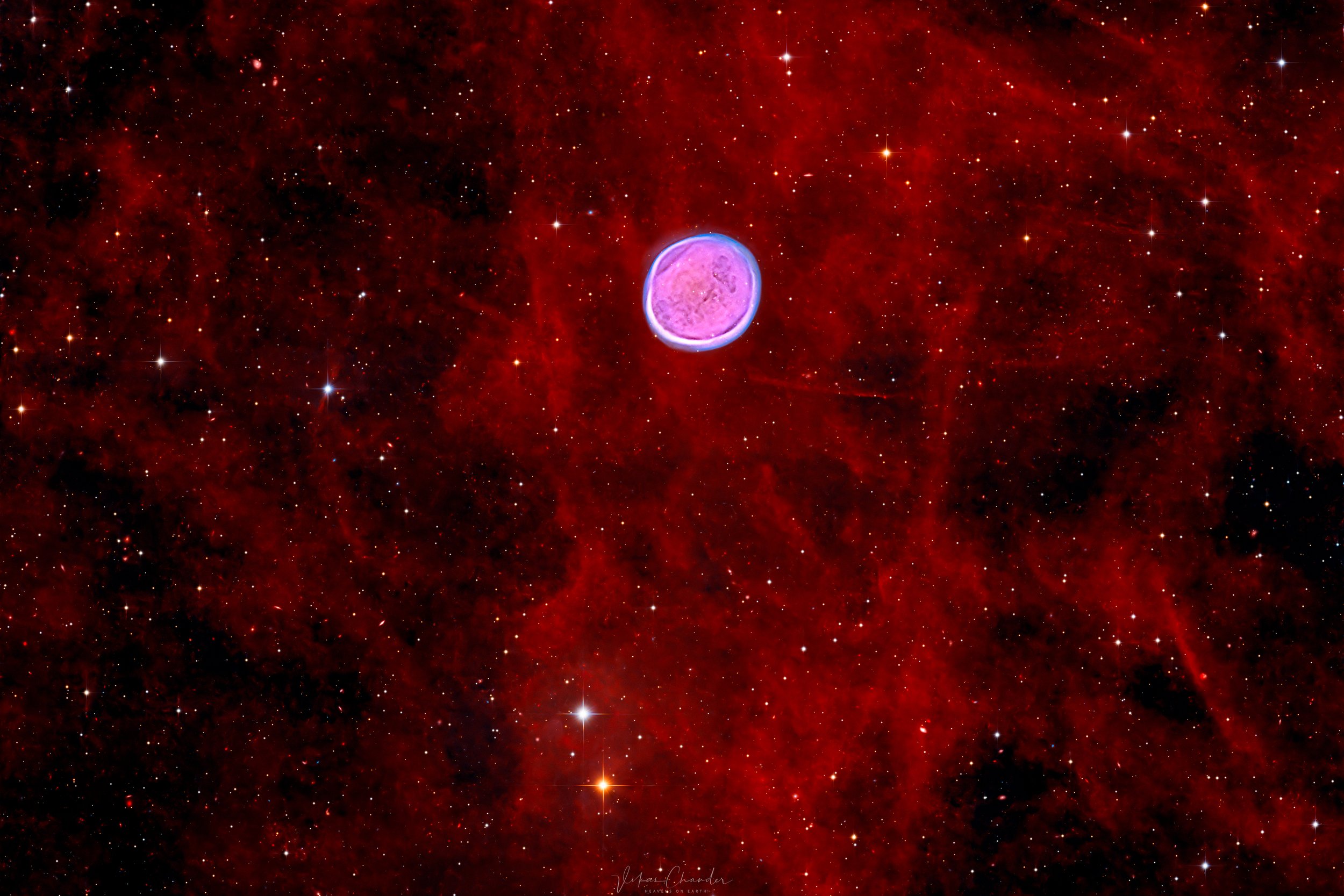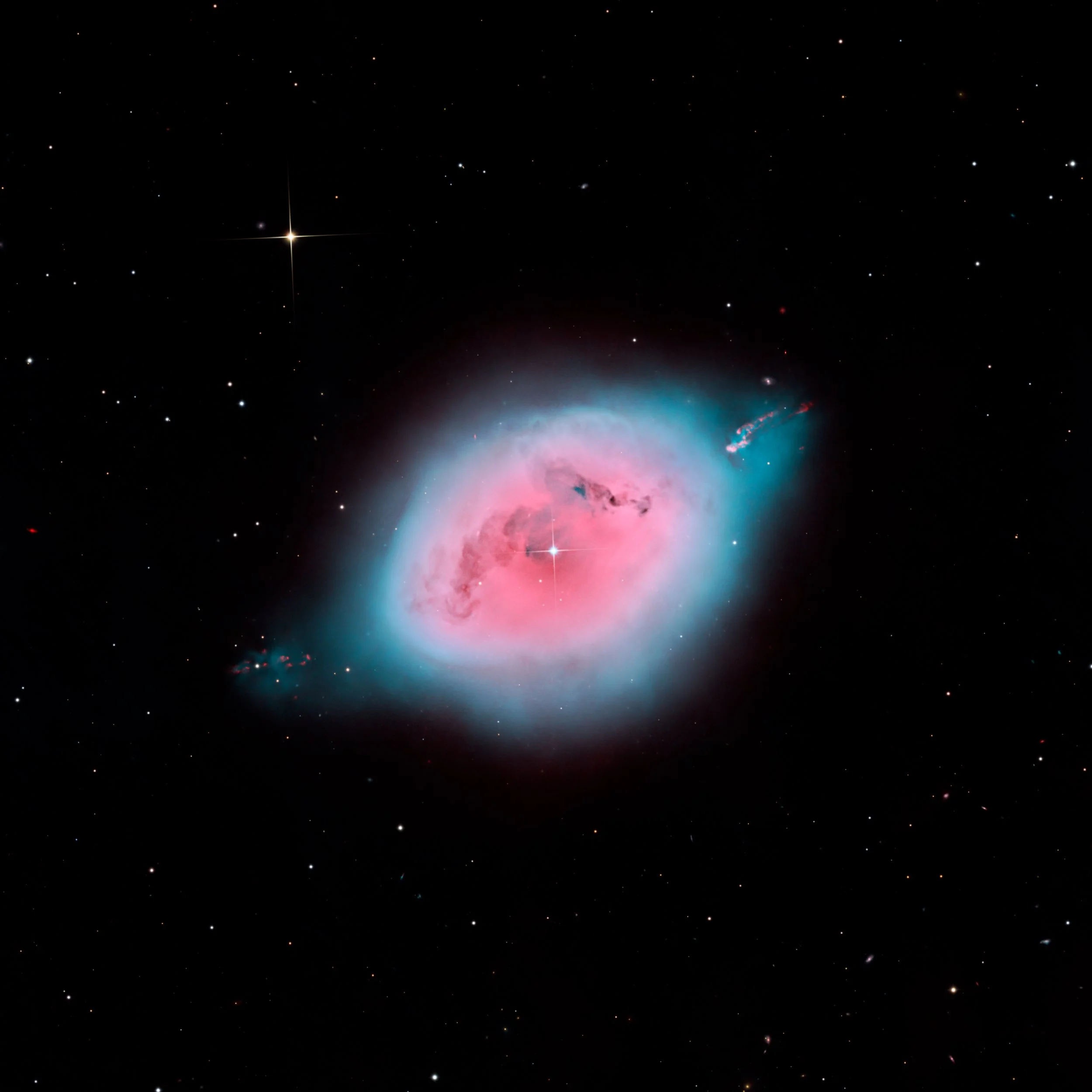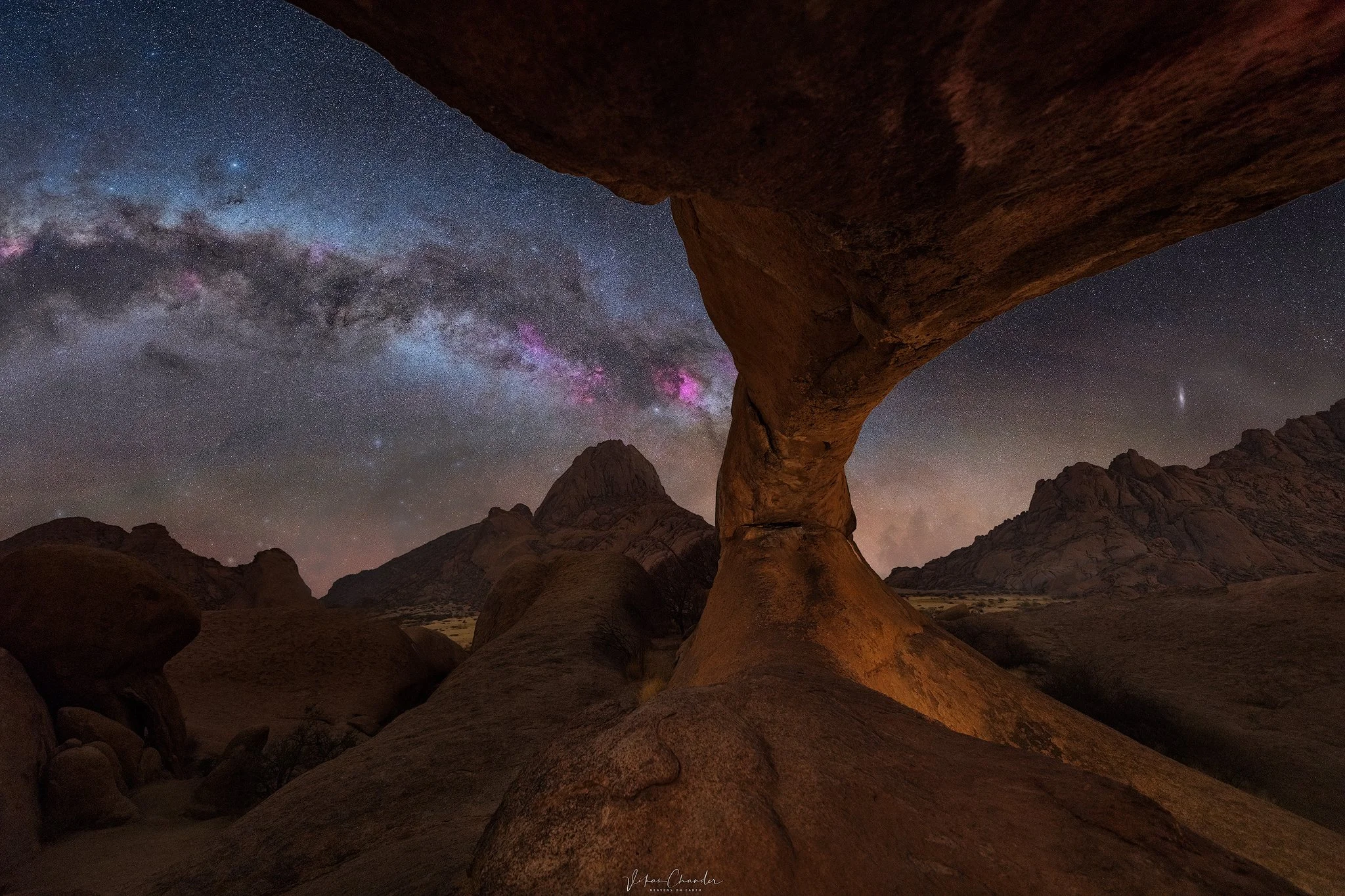
AAPOD2 Image Archives
The Southern Owl Nebula
This extraordinary bubble swimming in a glowing red sea of hydrogen may appear supernatural and mysterious to most, but it is a familiar astronomical object, a planetary nebula. Planetary nebulae are created by the ejected and expanding gas of a dying star and although they are brilliant and intriguing objects in the initial stages of formation, these bubbles fade away as their constituent gas moves away and the central stars grow dimmer.
Like all planetary nebulae, the Southern Owl Nebula, (scientific name ESO 378-1), is relatively short-lived, lasting only a few tens of thousands of years, compared to a typical stellar lifetime of several billion years. Located in the constellation of Hydra (The Female Water Snake), it’s informal name relates to its visual cousin in the Northern Hemisphere, M97 or the Owl Nebula.
The Pencil Nebula
The Pencil Nebula (NGC 2736), a brilliant filamentary structure in the Vela Supernova Remnant, is a striking testament to the power of a stellar explosion that occurred nearly 11,000 years ago. Situated 800 light-years away in the constellation Vela, this nebula is a fragment of the vast shockwave created when a massive star met its violent demise in a supernova.
Captured in a combined LRGB and SHO palette, this image unveils the intricate layers of ionized gas sculpted by the expanding remnant:
LRGB (Luminance, Red, Green, Blue) brings out the natural star colors and depth, emphasizing the nebula’s place within the galactic starfield.
Sulfur-II (SII) in deep reds and oranges reveals cooler, ionized gas pockets shaped by the passage of the shockwave.
Hydrogen-alpha (Hα) in golden yellows highlights the vast, ionized filaments weaving through the nebula.
Oxygen-III (OIII) in striking blue-greens traces the hotter, high-energy regions, marking areas where the supernova's blast wave continues to excite the surrounding interstellar medium.
Spanning nearly 5 light-years across, the Pencil Nebula moves at an astonishing speed of 650,000 km/h (400,000 mph) as it carves through space. The sharply defined, curving filaments contrast against more diffuse, wispy structures, a visual representation of the turbulent forces at play in this cosmic relic.
This multi-channel imaging approach reveals the nebula’s complex structure in unprecedented detail, showcasing the raw power of stellar death and the ongoing interactions that shape the interstellar medium. Over millennia, the nebula will continue to fade, dispersing its enriched materials into space, seeding the next generation of stars in a never-ending cycle of cosmic evolution.
NGC 1360: The Robin’s Egg of the Cosmos
Delicate and luminous, the Robin's Egg Nebula (NGC 1360) graces the constellation Fornax, offering a perfect symbol for New Year’s Day. Like the fragile egg it resembles, this planetary nebula represents new beginnings and infinite potential—a celestial reminder of the opportunities the year ahead holds.
Its soft blue glow comes from ionized gas, ejected by a dying star at its center, creating an elegant elliptical shape. This quiet transformation reflects the cycles of life and time, as one chapter ends and another begins.
Just as a robin’s egg protects the promise of new life, NGC 1360 invites us to look forward with hope and wonder, embracing the beauty and possibility of a fresh start under the vast expanse of the cosmos.
The Diamonds of Bogenfels
Location (was image taken with remote scope?): Namibia.
Image Description and Details: The mining ghost town of Bogenfels lies in the Sperrgebiet in South West Namibia. Sperrgebiet translated from German means the restricted area. The Sperrgebiet is an active diamond mining zone and one risks getting shot if not having the proper credentials and permits to enter the area. In times past the German colonizers had set up diamond mining towns and what we see here is a decrepit washing plant in which diamonds were separated from the soil they were excavated from. The diamonds on the ground are since long gone but the ones in the skies above, remain.
Resolved in the sky we see clockwise, from the Pleiades Star Cluster to the Taurus asterism with its dust clouds, and on to the Witch head Nebula. The distinctive Orion Molecular complex with the Horsehead nebula and the Barnard’s loop take center stage.
The Seagull Nebula appears further right before we loop back to the Rosette and Christmas tree Nebula and onward to the Flaming star Nebula before completing the circle at the California Nebula. Whew!
Sl7 Dark Nebula
SL7 is a dark nebula, a region of space so dense with interstellar dust that it obscures the light from stars and other objects behind it. Located in the Milky Way, dark nebulae like SL7 are fascinating to astronomers because they are the birthplaces of stars. These dense molecular clouds provide the raw materials for star formation, with gravity pulling the gas and dust together until nuclear fusion ignites a new star.
In this image, the dense, dark silhouette of SL7 stands out against the backdrop of the Milky Way, blocking the light from more distant stars. The intricate structures and variations in density within the nebula are visible, offering a glimpse into the complex processes at play in these stellar nurseries. Observing and studying dark nebulae like SL7 helps astronomers understand the early stages of star formation and the conditions that lead to the birth of stars and planetary systems.
Gum 15
Gum 15, nestled within the expansive reaches of the Carina Nebula in the southern skies, emerges as a celestial crucible of stellar birth and evolution. This emission nebula, also known as RCW 33, is situated approximately 7,500 light-years from Earth, within the vibrant tapestry of the Milky Way galaxy.
At the heart of Gum 15 lies a bustling stellar nursery, where dense clouds of gas and dust coalesce under the influence of gravity to give birth to new generations of stars. The intense radiation emitted by these young stars illuminates the surrounding nebula, casting it aglow with vibrant hues of pink and red, amidst the dark tendrils of dust that pervade the region.
Gum 15 offers astronomers a unique opportunity to study the processes of star formation in action. Through meticulous observation and analysis, scientists seek to unravel the intricate dynamics of this cosmic cauldron, shedding light on the fundamental processes that govern the birth and evolution of stars throughout the universe. As humanity delves deeper into the mysteries of Gum 15, it serves as a reminder of the boundless beauty and complexity of the cosmos, inspiring wonder and awe in all who contemplate its celestial splendor.
The Sting Ray Nebula
The Sting Ray Nebula, also known as Hen 3-1357, is a young planetary nebula located in the direction of the southern constellation Ara. What makes this celestial wonder particularly intriguing is its unique shape, resembling the graceful wings of a stingray. Formed from the outer layers of a dying star that has shed its material into space, the nebula showcases intricate patterns of ionized gas and dust, illuminated by the central, hot remnant of the star. The Sting Ray Nebula is relatively young on astronomical timescales, providing astronomers with a valuable opportunity to study the early stages of planetary nebula formation. Its captivating structure and youthful appearance make it a compelling subject for amateur astronomers and a source of scientific fascination in the exploration of stellar evolution.
The Unknown Whaler
In a remarkable capture taken near the Lighthouse of Pelican Point, an abandoned shipwreck took center stage against the backdrop of the remote landscape. However, it was the captivating beauty of the Milky Way that truly stole the show. With the celestial band of the Milky Way arching across the night sky, this cosmic display unveiled the intricate structure of our galaxy, a stunning tapestry of stars, dust, and gas. As the Milky Way's faint glow illuminated the shipwreck, the scene became a fusion of science and art, reminding us of our place in the vast cosmos and the profound connections between the universe and the stories of human history
Spitzkoppe Arch
Image Description and Details : The Spitzkoppe, or the "Matterhorn of Namibia", is a group of bald granite peaks located between Usakos and Swakopmund in the Namib desert of Namibia. More than 120 million years old, the highest outcrop rises about 1700mtrs above sea level. Many examples of Bushmen artwork can be seen painted on the rocks in the Spitzkoppe area though many of them have been destroyed. The Spitzkoppe Mountains were also the filming location for 2001: A Space Odyssey in the "Dawn of Man" sequences.
The rock arch seen here is also a well-known formation and has featured in many a composition and to photograph the arch, one has to camp inside the reserve as the gates are closed at night. Behind and to the left of the arch is the Spitzkoppe peak while to the right I think is the Pontos range. In the sky we can see the North American nebula and the Sadr region showing off their hydrogen gases and the Andromeda Galaxy puts in an appearance on the right, in an orientation we Northerners are not used to seeing….
Camera = Nikon D850 H-alpha mod
Lens = Nikon 14-24mm, Zeiss Otus 55mm
Sky Exposure = 10secs, f2, iso 6400, 18 panels
Ground Exposure = 480 secs, f2.8, iso 800, light painted
Software = PtGui, Pixinsight, Lightroom, Photoshop, Luminar Neo
Copyright: vikas chander
NGC 1999 Reflection Nebula
Image Description and Details :
One of the first images taken after NASA astronauts repaired the Hubble Space Telescope in December 1999, was NGC 1999, a nebula in the constellation Orion. While the Hubble image was much deeper than the image presented here, it nevertheless generated a lot of interest amongst astronomers. NGC 1999 is an example of a reflection nebula. Like fog around a street lamp, a reflection nebula shines only because the light from an embedded source illuminates its dust; the nebula does not emit any visible light of its own. NGC 1999 lies close to the famous Orion Nebula, about 1,500 light-years from Earth, in a region of our Milky Way galaxy where new stars are being formed actively. NGC 1999 was discovered some two centuries ago by Sir William Herschel and his sister Caroline, and was catalogued later in the 19th century as object 1999 in the New General Catalogue.Total Integration 24h40mLum 14x20m=4h40mRed 14x20m=4h40mGreen 14x20m=4h40mBlue 17x20m =5h40mHa = 10x30m=5h00m
Copyright: Vikas Chander
Witch Head Nebula
Image Description and Details : 2 Panel Mosaic of the Witch Head nebula
As the name implies, this reflection nebula associated with the star Rigel looks suspiciously like a fairy tale crone. Formally known as IC 2118 in the constellation Orion, the Witch Head Nebula glows primarily by light reflected from the star. The color of this very blue nebula is caused not only by blue color of its star, but also because the dust grains reflect blue light more efficiently than red. A similar physical process causes Earth's daytime sky to appear blue as well.
Telescope : Astro Physics 12″ Riccardi-Honders f3.8
Camera : ZWO ASI6200
Mount: Software Bisque Paramount ME II
Pixel scale : 1.07 arcsec/pixel
FOV : 88 x 66 arcmins
Filters :LRGB
Integration: 28h00m
L 30x20m R 18x20m G 18x20m B 18x20m
RA center: 05h05m52s.3
DEC center: -06°43′01″
Accquistion: NINA
Processing: PixInsight
Copyright: vikas chander
NGC 2170 Angel Nebula
Image Description and Details : Is this a painting or a photograph? In this classic celestial still life composed with a cosmic brush, dusty nebula NGC 2170, also known as the Angel Nebula, shines near the image center. Reflecting the light of nearby hot stars, NGC 2170 is joined by other bluish reflection nebulae, a red emission region, many dark absorption nebulae, and a backdrop of colourful stars. Like the common household items that still life painters often choose for their subjects, the clouds of gas, dust, and hot stars featured here are also commonly found in this setting -- a massive, star-forming molecular cloud in the constellation of the Unicorn (Monoceros). The giant molecular cloud, Mon R2, is impressively close, estimated to be only 2,400 light-years or so away. At that distance, this canvas would be over 60 light-years across.
Telescope : Planewave CDK 17 F6.8
Camera : SBIG STXL 11002
Mount: Software Bisque Paramount ME
Pixel scale : 0.63 arcsec/pixel
FOV : 42 x 29 arcmins
Filters :LRGB
Integration: 20h00m
L 15x20m R 15x20m G 15x20m B 15x20m
RA center: 06h08m24s.0
DEC center: -06°27′28″
Software: PixInsight
Copyright: Vikas Chander
Himalayan Chandra Telescope
Image Description and Details :
The Indian Astronomical Observatory (IAO), located in Hanle near Leh in Ladakh, India, has one of the world's highest sites for optical, infrared and gamma-ray telescopes. It is currently the tenth highest optical telescope in the world, situated at an elevation of 4,500 meters. Accessing the observatory, located near the Chinese border, requires a six hour drive from Leh, the capital city of Ladakh. The location is deemed to be excellent for visible, infrared and millimeter observations throughout the year due to its low temperatures, humidity, and light pollution. The Himalayan Chandra Telescope is a 2 meter optical-infrared telescope named after Nobel laureate Subramaniam Chandrasekhar. It is a modified Ritchey-Chretien system with a primary mirror made to withstand low temperatures. Imaging instruments include a Faint Object Spectrograph, a near infra-red and an optical CCD camera. The telescope is remotely operated via an INSAT-3B satellite link which allows operation even in sub-zero temperatures in winter.Camera – Sony A7iiiLens – Sony 50mm F1.4Tracker – Fornax LighttrackIIForeground – F11 30 secs iso 800Sky – F4 480secs iso 400Software - PixInsight and Photoshop
Copyright: Vikas Chander
Perseids over a 17th century monastery
Image Description and Details :
The image is of the Hanle Monastery under Bortle 1 skies and the Perseids. Hanle monastery is a 17th century gompa of the Drupka lineage of the kagyu school of Tibetan Buddhism located in the Hanle valley of Leh District, Ladakh, India. Hanle lies at an altitude of about 14500ft and is also home to the Indian Astronomical Observatory . The location of the monastery and the observatory is highly sensitive due to its proximity to the disputed Chinese border and access is restricted to a very few. Image was taken on the nights of 10 and 11-Aug-21. A blue hour foreground was first shot and then when the quadrant rose, 20 images of the night sky were stacked with the meteors blended in.
Copyright: Vikas Chander and Dorje Angchuk
NGC 3576
NGC 3576
NGC 3576 is a bright emission nebula, whose popular nickname is "The Statue of Liberty Nebula" because of the distinctive shape in the middle of the nebula. It is approximately 100 light years across and 9000 light-years away from Earth and is located in the Sagittarius arm of our galaxy and a few thousand light-years away from the Eta Carinae nebula. Within the nebula, episodes of star formation are thought to contribute to the complex and suggestive shapes. Powerful winds from the nebula's embedded, young, massive stars shape the looping filaments. It was discovered by William Herschel on 16 March 1834 and the name was first suggested in 2009 by Dr. Steve Mazlin, a member of Star Shadows Remote Observatory (SSRO).
7 hrs each of SHO filters and 30mins each of RGB filters for stars replacement.
Processed in Pixinsight with a final flourish in Photoshop
Copyright: Vikas Chander

















